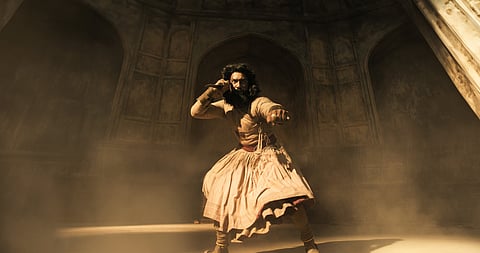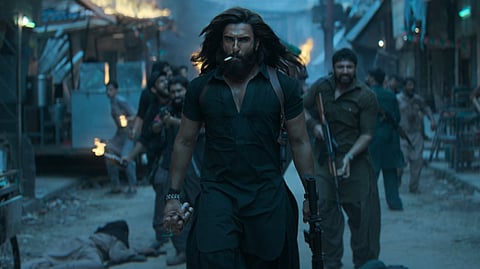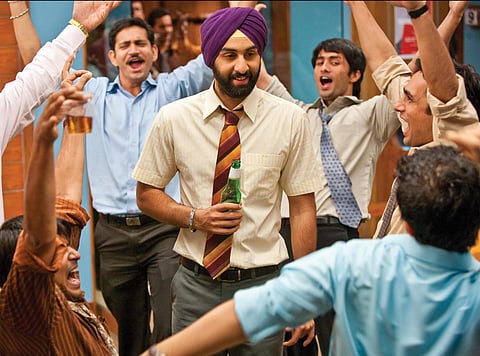A burly, bearded Ranveer Singh, wearing rings on fingers, strikes a match below his boot and lights up his cigarette. His face is bloody, he’s sporting long hair, there’s an air of nonchalance —the image has most ingredients of a Bollywood hero’s money shot. The scene appears in the teaser of Aditya Dhar’s Dhurandhar, based on sketchy details of covert operations attributed to India’s NSA chief Ajit Doval (played by R Madhavan). It’s no surprise that the first few comments under the trailer on YouTube compare Singh’s look in his latest film to his earlier performance as Alauddin Khilji in Sanjay Leela Bhansali’s Padmaavat (2018) and Sandeep Reddy Vanga’s Animal (2023). Singh, who has only seen two hit films in Karan Johar’s Rocky Aur Rani Ki Prem Kahaani (2023) and Zoya Akhtar’s Gully Boy (2019), out of five films in the last six years, looks determined to make a statement with his latest film—no matter, what the cost.
The 600-Crore Blockbuster: How Bollywood Abandoned Civility To Plot Its Comeback
If there ever was a memo going around for tentpole Hindi films, it’s never been clearer than this. Historicals/mythology, patriotism and hypermasculinity seem to be the flavours of a nation.
The Dhurandhar teaser comes only a few days after the first look of Nitesh Tiwari’s magnum opus adaptation of Ramayana, featuring Hans Zimmer in the credits, collaborating with AR Rahman for the score. This is what the Hindi tentpole leading man has become: either a pious symbol, or a blood-thirsty man, whose violence can be rationalised by family, nation or larger dharma (duty; often interpreted as religious duty). The teasers for Ranbir Kapoor and Ranveer Singh’s films come out only a few months after the blockbuster success of the Vicky Kaushal-starrer, Chhaava, which made close to Rs 700 Crore at the box office.

If there ever was a memo going around for tentpole Hindi films, it’s never been clearer than this. Historicals/mythology, patriotism and hypermasculinity are flavours of the nation. Dhurandhar’s teaser, in its span of 159 seconds, has at least a dozen shots of characters smoking in slow-motion, as the camera frames them looking sleek. Singh shows off his perfectly sculpted biceps, the cold stare from behind light contact lenses, a wild mane, and an unkempt beard.
Perhaps Dhar’s logic is that since Singh’s character is a deep-undercover operative, he has to look the part of someone capable of infiltrating terror outfits across the border. But if the teaser is to be believed, Singh’s character will have all the slow-motion afforded to a Hindi film ‘hero’, and a love interest too (20-year-old Sara Arjun being cast opposite a 40-year-old Singh, keeps the tradition alive of the Khans in their 50s being paired with actresses in their 20s and 30s). Dhar, known for his lopsided politics, showcases a few scenes where he equates barbarism with pronounced Muslim iconography. A character is seen attacking someone with a butcher’s knife, a heavily-bearded Arjun Rampal smiles menacingly showing his gold teeth, there’s a cold, blue tint in some scenes—which has become Bollywood’s short-hand for depicting Muslim ghettos. It is visual stereotyping masquerading as gritty realism.

Filmmaking is an expensive business, and in the current environment, it’s understandable that the producers want only the tried-and-tested. But what that means in the contemporary set-up is an industry actively trying to cash in on religious and jingoistic fervour, when it's not busy catering to hypermasculinity. It’s no surprise then that one of the most high profile releases next year is Aashiqui 3, for which Kartik Aaryan has been parading around with an unusual amount of face fuzz.
Kapoor, Singh and Kaushal—three of the biggest star-actors at the moment—began their career playing politically-sensitive, socially-curious underdogs. They were once seen as the vanguard of new Bollywood: politically conscious, emotionally layered, resistant to macho clichés. Kaushal’s breakout role was that of a Dalit boy from Varanasi, while Singh and Kapoor played scions of rich families, who are also aimless wanderers on the inside. After his breakout in Uri: The Surgical Strike (2019), Kaushal unsuccessfully tried his hand at feel-good social dramedies like Govinda Mera Naam (2022), The Great Indian Family (2023) and Zara Hatke Zara Bachke (2024). While Singh has burned his fingers with Jayeshbhai Jordaar (2022) and 83 (2023), Kapoor stumbled with Shamshera (2022) and Brahmastra (2023).

Walking on the path of the most lucrative roles (borrowing a leaf out of Shah Rukh Khan’s action film era, Allu Arjun’s Pushpa series, and Prabhas’s mythological films), it appears like they’ve made their peace with what they have to do, to take their careers to the next level. It’s a pity to see them going down this road, considering they’re all compelling actors, who many might have believed, were capable of using their powers to restore decency in Bollywood.
Maybe they know it better than most. Societies will come and go, there will be the odd riot triggered by gullible, film-crazy fans. But a Rs 600-crore blockbuster? That lasts forever.
Tags